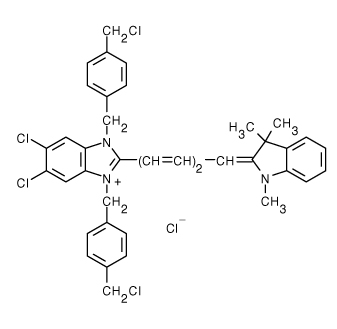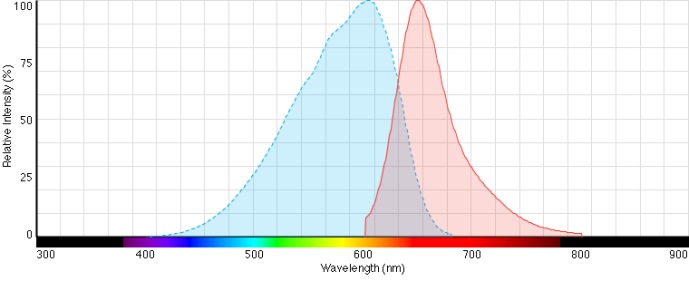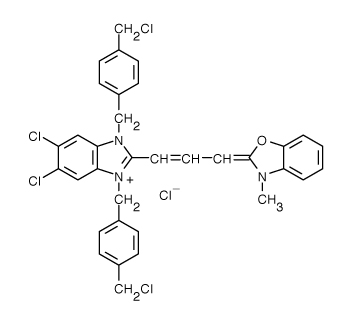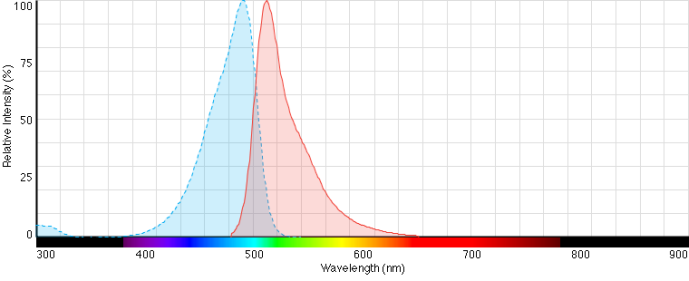Principle and Target:
Mitochondria have an outer membrane with relatively large pores, where small molecules can pass readily, while the inner membrane is tight (otherwise the proton gradient could not be sustained). Due to the transport of electrons in the respiratory chain, the inner membrane is charged. Therefore it is attractive for positively charged molecules (such as sodium ions). Most dyes that stain the ER, also stain mitochondria, such as Rhodamine G6 chloride or DioC6. In the moment that cells are chemically fixed, such that membrane potentials break down, such dyes fail to stain mitochondria. For this purpose, Molecular Probes developed the so called Mitotracker series of dyes. The so called FM series (FM stands for Fei Mao, the researcher, who developed these dyes) is based on carbocyanide and can pass the cell membrane and therefore can be used for vital labelling of mitochondria.
Note: there are two versions Mitotracker Red FM and Mitotracker Green FM. They are not only different in colour, but also in their property:
- Labelling of Mitotracker Red FM depends on the membrane potential, i.e. dysfunctional microtubules are labelled less than vital mitochondria. It can be used for immunofluorescence, because it is not washed out after fixation.
- Labelling of Mitotracker Green FM is independent of membrane potential, but is washed out. It can therefore not be used for immunofluorescence.
Chemical properties:
- Mitotracker Red FM is absorbing at 581 nm (green light) and emits at 644 nm (red light). MW 724
- Mitotracker Green FM is absorbing at 480 nm (blue light) and emits at 516 nm (green light). MW 672
Application:
- purchasable by Thermo Fisher (M22425 for Mitotracker Red FM; M7514 for Mitotracker Green FM)
- Mitotracker Red FM stock solution 1 mM in DMSO, keep at -20°C and secured from light.
- Mitotracker Green FM stock solution 1 mM in DMSO, or in water (not fluorescent in water)
- working concentrations in plant cells (tobacco BY-2) 200 nM (Eggenberger, unpublished)
- for life-cell imageing Mitotracker Green FM is preferable, it is added 5 min prior to observation, no wash out is needed, because the concentration is very low, such there is virtually no background
Caveat:
- like any fluorescent dye binding to a target, one has to be careful about side effects in life-cell imageing (what is labelled, is changed!). Kai Eggenberger has followed this up (unpublished supplement, Fig. S4, pdf) - 200 nM Mitotracker Green FM over 72 h do not impair viability in non-transformed BY-2 WT, but reduce by around 20% in the actin marker line FABD2-GFP. After long-term treatment (14 h), mitochondria were found to be fused, this effect was not seen at 2 h (unpublished supplement, Fig. S3, pdf).
- Conclusion: if you use Mitotracker for life-cell imageing, it is preferrable to keep treatment time short. If one needs to follow mitochondria in one cell over time, one should keep in mind that after a few hours mitochondria will show artifacts. If one wants to see mitochondria in different cells after different time points of a treatment with an other factor, it is advisable to add the Mitotracker just 5 min before observation.
- In the protocol provided by Thermo Fisher, incubation at 37°C is included. Please note that this protocol is targeted to medical applications (mammalian cells). For plant cells, 25°C is fine enough. Tobacco cells will also cope with 37°C, since Nicotiana tabacum is a tropical species, but for other cells (such as Vitis), at 37°C already heat stress effects are observed.
References:
- Molecular Probes information on fluorescent probes for plant cells with a short section on mitochondrial probes and references - pdf
- Jaipargas EA, Barton KA, Mathur N, Mathur J (2015) Mitochondrial pleomorphy in plant cells is driven by contiguous ER dynamics. Front. Plant Sci. 6: 783 - pdf (very interesting paper on the link between mitochondria and ER from the Mathur lab, they use a different Mitotracker which is voltage-sensitive)
Publications from our group using this dye
128. Rajabi F, Heene E, Maisch J, Nick P (2017) Combination of plant metabolic modules yields synthetic synergies. PLoS ONE 12, e0169778 - pdf
unpublished supplement to Birtalan et al., where Kai Eggenberger investigates toxicity and side effects of a mitochondria-targeted peptoid along with Mitotracker Green FM - pdf




